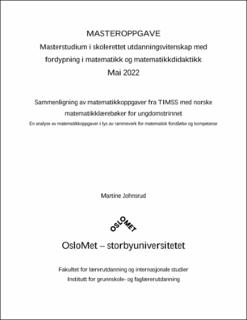| dc.description.abstract | Dette forskningsprosjektet er en matematikkdidaktisk masteravhandling som tar for seg en sammenligning av matematikkoppgaver fra den internasjonale undersøkelsen TIMSS – Trends in International Mathematics and Science Study og to norske læreverk. Når det gjelder TIMSS, ser jeg på matematikkoppgavene for 8. og 9. trinn fra undersøkelsene som ble gjennomført i 2015 og 2019. Prosjektet tar for seg alle matematikkoppgavene fra 8. og 9. trinn i de to læreverkene, tillegg til de frigitte oppgavene fra TIMSS, totalt antall oppgaver er 2313. Fagområdene som er gjennomgående i prosjektet vil derfor være tall, geometri, statistikk og algebra. Problemstillingen min er: Hvordan fremstår matematikkoppgaver fra TIMSS for ungdomstrinnet sammenlignet med oppgaver fra norske lærebøker når de analyseres ved hjelp av rammeverk for kompetanse og forståelse? Jeg tar utgangspunkt i teoriene til Richard R. Skemp (2006) og Jeremy Kilpatrick (2001) om matematisk kompetanse og forståelse, samt de kognitive nivåene fra TIMSS Mathematics framework (Grønmo et al., 2013; Lindquist et al., 2017). Jeg analyserer matematikkoppgavene basert på både en kvalitativ og kvantitativ metodetilnærming. Jeg tar utgangspunkt i Philipp Mayring (2015) sin induktive kategoridannelse for å utvikle et klassifiseringsverktøy som brukes til å analysere matematikkoppgavene i lys av de nevnte teoriene. Klassifiseringsskjemaet brukes deretter til å sammenligne ulike aspekter ved oppgavematerialet i TIMSS med oppgavene fra lærebøkene, blant annet prosentvis fordeling av fagområde og kognitive nivåer. Deretter sammenligner jeg statistiske mål som gjennomsnitt og spredningsmål, samt ser på mål av korrelasjon gjennom Pearsons R og benytter kategorisk krysstabell. Ved å bruke disse teoriene og denne metodiske tilnærmingen undersøker jeg i hvilken grad matematikkoppgavene i lærebøkene samsvarer med matematikkoppgavene i TIMSS-undersøkelsen. Funn fra analysen viser at fagområdet algebra blir vektlagt i større grad i matematikkoppgavene fra TIMSS, dette kan gi en forklaring på de relativt dårlige norske prestasjonene innenfor algebra i de tidligere undersøkelsene. Lærebøkene vektlegger fagområdet tall i stor grad, det viser seg at over 50 % av lærebøkenes samlede innhold har matematikkoppgaver som tilhører fagområdet tall. Her er det Faktor 8 som bidrar med flest talloppgaver. En sammenligning av matematikkoppgavene fra hvert læreverk viser at det er en variasjon i hvordan oppgavene er utformet og hva slags type oppgaver læreverkene vektlegger. Faktor fokuserer i stor grad på mengdetrening, og har en stor andel oppgaver som kun krever utregning ved bruk av algoritme. Tekstoppgavene fra lærebøkene og TIMSS har i stor grad lik utforming. Det kognitive nivået «å resonnere» tar mindre plass i lærebøkene enn i TIMSS. Færre problemløsningsoppgaver i lærebøkene kan ha innvirkning på dette. «Å anvende» vektlegges derimot i stor grad i lærebøkene, noe som kan være forklaringen på at resonnering ikke blir vektlagt.
This research project is a mathematics education master thesis that covers a comparison of mathematical tasks from the international survey TIMSS - Trends in International Mathematics and Science Study and two Norwegian textbooks. Considering the TIMSS survey, I have selected the mathematics tasks that was conducted in 2015 and 2019 for 8th and 9th grade. The project includes all the mathematical subject areas from the textbooks as well as the released assessment tasks from the TIMSS survey, a total of 2313 tasks. The subject areas are numbers, geometry, statistics, and algebra. The main research question I will be answering through this thesis is: How do mathematical tasks from TIMSS for the lower secondary school, grade 8, compare to tasks from Norwegian textbooks when they are analyzed using frameworks regarding proficiency and understanding? I use Richard R. Skemp´s (2006) and Jeremy Kilpatrick´s (2001) theories regarding mathematical proficiency and understanding, as well as the cognitive levels from TIMSS Mathematics
framework (Grønmo et al., 2013; Lindquist et al., 2017). I analyze the mathematical tasks based on a qualitative and quantitative methodological approach. Through Philipp Mayring's (2015) inductive category formation I developed a classification scheme to analyze the mathematics tasks using the mentioned theories. The classification scheme was then used to compare different aspects of the task material in the TIMSS survey with the tasks from the textbooks, including the percentage distribution of subject area and cognitive levels. A comparison of statistical measures such as average and scatter measures, as well as see measures of correlation through Pearson's R and a use of categorical cross-tabulation, are methods also used in the analysis. Using these theories and this methodological approach, I investigate whether the mathematics tasks from the textbooks correspond with the mathematics problems from the TIMSS survey. Findings from the analysis show that the subject area algebra is emphasized to a greater extent in the assessment items from TIMSS, this may provide an explanation for the relatively poor Norwegian performance in algebra shown in the previous surveys. The Norwegian textbooks emphasize the subject area numbers to a great extent, it turns out that this subject area covers more than 50% of the textbook mathematical content. Here, Faktor 8 contributes with most of the mathematics tasks covering the subject area numbers. A comparison of the mathematics tasks between the textbooks shows that there is a variation in how the tasks are structured, and what type of problems the textbooks emphasize. Faktor focuses mainly on routine exercises and has a large proportion of tasks that only require calculation using an algorithm. The tasks involving a story, or a text. have a largely similar design. The cognitive level “reasoning” takes a smaller role in the Norwegian textbooks than in TIMSS. Fewer problem-solving tasks in the textbooks can have an impact on this. “Applying”, on the other hand, is emphasized in the textbooks to a larger extent, which may be the reason why reasoning is less emphasized. | en_US |
